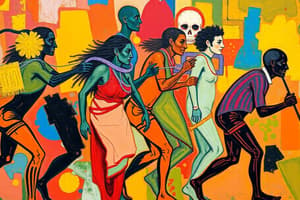Podcast
Questions and Answers
Which of these academic disciplines is NOT typically considered a part of the social sciences?
Which of these academic disciplines is NOT typically considered a part of the social sciences?
- Psychology
- Sociology
- Economics
- Literature (correct)
The illustration from the Life Nature Library book, "The March of Progress", depicts which of the following concepts?
The illustration from the Life Nature Library book, "The March of Progress", depicts which of the following concepts?
- The importance of cultural development in human evolution, showcasing the gradual emergence of tools and complex social structures.
- A linear progression of human evolution, starting with early hominids and culminating in modern humans. (correct)
- The impact of environmental factors on human evolution, showing how different species adapted to diverse landscapes.
- The complex and interconnected nature of human evolution, showing how various species co-existed and interacted.
What is the central argument of the "Galactic Perspective"?
What is the central argument of the "Galactic Perspective"?
- The vastness of the universe emphasizes the insignificance of humanity in the grand scheme of things.
- The vastness of the universe highlights the interconnectedness of all life forms on Earth.
- The vastness of the universe inspires us to explore and understand the mysteries beyond our planet.
- By understanding the scale of the universe, we can better appreciate the uniqueness and complexity of life on Earth. (correct)
Which of the following is NOT considered a subfield of anthropology?
Which of the following is NOT considered a subfield of anthropology?
According to the lecture, what are the primary factors that account for differences between human populations?
According to the lecture, what are the primary factors that account for differences between human populations?
Which of the following is a key concept in cultural anthropology?
Which of the following is a key concept in cultural anthropology?
What is the main focus of applied anthropology?
What is the main focus of applied anthropology?
Which of the following is an example of an extra credit opportunity mentioned in the lecture?
Which of the following is an example of an extra credit opportunity mentioned in the lecture?
What is the primary focus of biological anthropology?
What is the primary focus of biological anthropology?
Which biological measures are commonly associated with biological anthropology?
Which biological measures are commonly associated with biological anthropology?
What is the goal of studying primatology within biological anthropology?
What is the goal of studying primatology within biological anthropology?
Which of the following subfields blends biological anthropology with archaeology?
Which of the following subfields blends biological anthropology with archaeology?
What does the Tsimane Life History Project focus on?
What does the Tsimane Life History Project focus on?
Which essential function does NOT contribute directly to human survival?
Which essential function does NOT contribute directly to human survival?
What is the main factor influencing the variation in color perception among different cultures?
What is the main factor influencing the variation in color perception among different cultures?
Which statement best describes the process of enculturation?
Which statement best describes the process of enculturation?
How does culture impact what is considered edible?
How does culture impact what is considered edible?
Which of the following pairs represent intra-cultural variation?
Which of the following pairs represent intra-cultural variation?
What is indicated by the phrase 'culture is invisible, like the water for the fish'?
What is indicated by the phrase 'culture is invisible, like the water for the fish'?
Which example illustrates the interplay between biology and culture in eating habits?
Which example illustrates the interplay between biology and culture in eating habits?
Which of the following best captures the holistic view of anthropology?
Which of the following best captures the holistic view of anthropology?
What is the main distinction between archaeology and cultural anthropology?
What is the main distinction between archaeology and cultural anthropology?
What is the shared objective of all subfields of anthropology?
What is the shared objective of all subfields of anthropology?
How does the example of the ‘rooster’ sound demonstrate the concept of cultural meaning?
How does the example of the ‘rooster’ sound demonstrate the concept of cultural meaning?
What is the purpose of the ‘What did the horse say?’ section in this text?
What is the purpose of the ‘What did the horse say?’ section in this text?
What is the main argument presented in the section about color classification?
What is the main argument presented in the section about color classification?
Which of the following best describes the concept of culture as presented in the text?
Which of the following best describes the concept of culture as presented in the text?
Why is culture described as a ‘tool’ for humans?
Why is culture described as a ‘tool’ for humans?
Which of the following is NOT a key characteristic of culture as described in the text?
Which of the following is NOT a key characteristic of culture as described in the text?
Flashcards
Biological Anthropology
Biological Anthropology
The study of humans as biological organisms from an evolutionary perspective.
Human Behaviors
Human Behaviors
Adaptive solutions to balance survival demands like parental care and food acquisition.
Primatology
Primatology
Research on the behavior of primates to understand human behavior.
Human Paleontology
Human Paleontology
Signup and view all the flashcards
Forensic Anthropology
Forensic Anthropology
Signup and view all the flashcards
Anthropology
Anthropology
Signup and view all the flashcards
Fields of Anthropology
Fields of Anthropology
Signup and view all the flashcards
Cultural Anthropology
Cultural Anthropology
Signup and view all the flashcards
Linguistic Anthropology
Linguistic Anthropology
Signup and view all the flashcards
Archaeology
Archaeology
Signup and view all the flashcards
Natural Sciences
Natural Sciences
Signup and view all the flashcards
Humanities
Humanities
Signup and view all the flashcards
Anthropological Subfields
Anthropological Subfields
Signup and view all the flashcards
Culture
Culture
Signup and view all the flashcards
Cross-linguistic Onomatopoeias
Cross-linguistic Onomatopoeias
Signup and view all the flashcards
Interpretation of Stimuli
Interpretation of Stimuli
Signup and view all the flashcards
Shared System of Meaning
Shared System of Meaning
Signup and view all the flashcards
Classification of Color
Classification of Color
Signup and view all the flashcards
Color Identification
Color Identification
Signup and view all the flashcards
Enculturation
Enculturation
Signup and view all the flashcards
Inter-Cultural Variation
Inter-Cultural Variation
Signup and view all the flashcards
Intra-Cultural Variation
Intra-Cultural Variation
Signup and view all the flashcards
Basic Human Functions
Basic Human Functions
Signup and view all the flashcards
Cultural Definition of Edibility
Cultural Definition of Edibility
Signup and view all the flashcards
Biological vs Cultural Influence
Biological vs Cultural Influence
Signup and view all the flashcards
Study Notes
Announcements
- Crash/switch: Follow Canvas procedure for switching sections; spots still available
- Syllabus quiz: Due next Friday
- Office hours: Wednesday 1-2pm and Thursday 2-3pm, HSSB 2073
Extra Credit Opportunities
- Attend one event, write a short report. Up to 5 opportunities this quarter. Check Canvas for guidelines and events.
- "Um Pasto bem Limpinho": Settler perspectives on Amazonian landscapes.
- Professor Jeffrey Hoelle, UC Santa Barbara
- Monday, January 13, 11am-12pm, Henley Board Room at Mosher Alumni House
Today's Topics
- Humans in a broader context across time and space
- Anthropology as the study of humans
- Definition of culture
- Readings: AQ 1
Additional Information
-
Images of the Milky Way, solar system, and life on Earth over time are included.
-
A chart of human evolution is presented (March of Progress).
-
Human population growth over time is shown, with major events like the Industrial Revolution, Agriculture and Green Revolution, and antibiotics.
-
What is culture?
-
What are differences between humans and other animals?
-
Four fields of anthropology:
-
Biological anthropology
-
Archaeology
-
Cultural anthropology
-
Linguistic anthropology
-
Applied anthropology
-
Different sub-fields use different methods and evidence to learn about humans as both cultural and biological beings.
-
The study of humans from a biological perspective; as physical and biological organisms.
-
Human behaviors, adaptations (and behavioral)
-
DNA, blood, cortisol levels, body size, to explore human variation.
-
Parental care, mate selection, food acquisition
-
Primatology- studying closest animal relatives (primates) to better understand human behaviors like cooperation, competition, and mate selection.
-
Human paleontology, bio-archeology: Analyzing biological and chemical data from ancient human remains (fossils)
-
Forensic anthropology: Analyzing and identifying recent human remains
-
Archaeology: The study of human cultures in the past, understanding human cultures through material culture (stone buildings, tools, graves, trash piles etc)
-
Cultural anthropology: Study of human thought, behavior, life ways; focus on present or recent history. Regional and topical specializations.
-
What is culture?
-
What does it mean for us to interpret things culturally?
-
Different ways humans classify colors, the ways societies experience and interpret colors.
-
The interplay of nature and culture is elaborated.
Studying That Suits You
Use AI to generate personalized quizzes and flashcards to suit your learning preferences.




